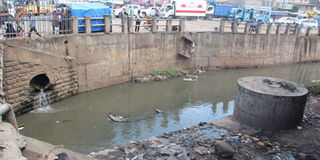Census report reveals Kenya's sanitation crisis

Raw sewage emptying from a tunnel into Nairobi River on December 5, 2017, causing water pollution in the river that runs across downtown Nairobi. PHOTO | FILE | NATION MEDIA GROUP
Only 9.7 per cent of the national population use the main sewer line for human waste disposal, confirming once again the dire sanitation crisis the country is facing.
Data from the recently released census report has revealed that a majority of Kenyan households opt for other modes of human waste disposal because they are not connected to the main grid provided by their respective county governments.
More than half of the 12 million households recorded in the country use covered pit latrines, with more than 61 per cent of those in the rural areas and 34 per cent in urban areas using this mode of human waste disposal.
A significant number of households also use uncovered pit latrines and the open bush for human waste disposal. The data from the Kenya National Bureau of Statistics shows that 12.5 per cent of rural households and 4.4 per cent in urban areas use uncovered pit latrines while 11.5 per cent of those in rural areas and 0.8 per cent in urban areas use the open bush.
According to a report by the World Bank in 2018, Kenya was among one of the countries that did not achieve the Millennium Development Goal for increasing access to water and sanitation. For a long time managing both solid and human waste has been a challenge for the country, particularly in middle and low income areas.
A closer look at the census data shows that urban areas such as Nairobi, Mombasa and Kisumu have a higher connectivity to the main sewer line.
The leading is Nairobi, which more than 54 per cent of its households are use the main sewer. In Mombasa and Kisumu, the proportion of the population connected to the main sewer line are 16.6 per cent and 4.8 per cent respectively.
It presents concern that a majority of households in the country use covered pit latrines for human waste disposal, particularly in more urbanised regions such as Kisumu and Nyeri who both are at 65.4 per cent and 66.3 per cent respectively. Counties such as Mombasa, Bungoma and Baringo also use covered pit latrines more than any other mode of waste disposal.
However, in the North-eastern region a majority of households use the bush for human waste disposal with very few using the main sewer. In Marsabit, 47.4 per cent of households use bush as a mode of disposal, the highest in the region. This is followed by Wajir at 43.6 per cent, Mandera at 39.4 per cent, Garissa at 35.2 per cent and Isiolo at 30.6 per cent.
Slow progress
The last 20 years has seen a slow improvement of sanitation in the country has, showing little change even with the development of infrastructure such as roads and advances electricity and mobile connectivity.
There have been several calls to upgrade and develop innovative solutions towards the containment, collection, disposal and treatment of waste in both rural and urban areas, including the upcoming Water and Sanitation Conference scheduled for next month.
The challenge of sanitation is more apparent in rural areas as compared to urban areas as people continue to defecate in the open, primarily due to availability of open land. This, however, poses a threat to the health of people as cases of cholera and typhoid keep emerging in the country.
On the other hand, urban areas face challenges of improper planning and over population which has exerted pressure on the existing sewer lines. According to reports by Water, Sanitation and Hygiene (WASH), Nairobi City Water and Sewerage Company cannot account for the disposal of over 66 percent of human waste. Because of this, it is often a common sight to see busted sewer lines within estates in Nairobi.
Even as the rest of the world is pushing towards achieving universal sanitation coverage by 2030, and ending open defecation by this year, data shows that Kenya still has a long way to go.





